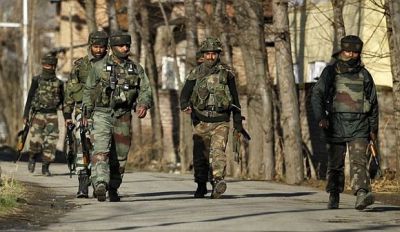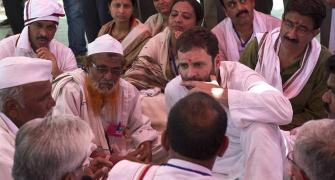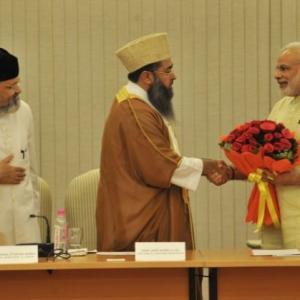
'I am aware that mention of a threat to Gulmarg emanating from my perception may send negative signals to tourists, but there are realities which need to be taken stock of.'
'Gulmarg is not far from Srinagar and is what the army calls in its parlance "a big name place." Such places draw attention much faster when negative incidents take place and give value of eyeball attraction,' says Lieutenant General Syed Ata Hasnain (retd).
After the political fireworks early this year Jammu and Kashmir has had a well-deserved rest except for the Pakistani flags which have kept some turbulence alive along with speculation.
The summer has also been quiet, but true to tradition, violence at the Line of Control seems sparking the season and waking observers from slumber.
A virtual suicide attack at Tangdhar last Sunday, May 31, that left three terrorists dead; another infiltration bid in the same sector three days before left one terrorist dead for the cost of three soldiers, an obverse ratio; it does happen at times, no criticism of the army on that.
The more important question -- why is this happening now, why at Tangdhar and is there a deeper sinister plot behind this.
First, a few things a strategic mind should notice. Tangdhar has had its history of traditional infiltration; it has had attempts by Pakistan's Border Action Teams too, but a suicide attack near an army establishment is new.
Well, really not so new. After the December strike of a similar nature at Uri in the Jhelum valley, I did assess and project that this could be the nature of threats in future.
The pattern set by shallow infiltration and repeated targeting of Kathua and Samba in the Jammu division also gave similar indications. It was quite evident that infiltration in the Kashmir division and Poonch-Rajouri sectors was becoming increasingly difficult.
The attrition levels were and are still high. With limited terrorists on ground, it is becoming difficult to strike at important targets in hinterland areas which will draw attention to satisfy the ISI masters across the LoC.
Tangdhar and Uri are best known for transient militancy/terrorism; that means terrorists use these areas to infiltrate and move into the hinterland for deeper strikes. Both areas have a large number of guides who are not ideologically oriented; they are in the business of guidance of terrorists basically for money.
However, now these areas have been subjected to terrorist strikes because it is relatively simpler to infiltrate there. In Tangdhar the LoC fence runs relatively in depth and there are gaps.
In the case of Uri the traditional infiltration routes emanate from very high mountain passes and the LoC fence is usually buried deep under snow even at this time. There are high altitude areas which are impossible to fence. Counter infiltration anyway does not guarantee a zero figure because the terrain is rugged and interspersed with jungle.
Infiltration attempts to reach reception areas in depth increase chances of terrorist attrition. Getting experienced reception parties to designated reception centers dilutes the strength from that available for strikes in depth areas because an infiltration into the Valley is not a 24 hour affair; it can stretch into a couple of weeks.
In the face of all this, it is far easier and almost as lucrative to strike at targets north of the Shamshabari range, Jhelum valley and the thus far untried Gulmarg. The army and other security agencies particularly those involved in intelligence gathering have a new task cut out for them.
Securing the installations in the vicinity of the LoC means weaning strength from the counter infiltration grid which in turn will facilitate more infiltration.
Pakistan's Deep State has been adept at innovating and taking the battle to different areas as per convenience thrown up by analysis. However, their ploy this time if read correctly is likely to be countered early.
In many ways the army would probably be happier with the change in tack and focus. The possibility of collateral damage gets reduced the closer you get to the LoC.
Operations are comparatively less complicated because there is no danger of threats such as agitation and stone throwing which is usually so in Shopian or Sopore. These areas close to the LoC are inhabited by the Gujjars or the Paharis who speak different dialects of Dogri, are loyal to India and are no great friends of the Kashmiris residing at the Valley floor.
Tangdhar also has a large segment of Shias in Karnah tehsil. That makes for better intelligence too. The army has to be careful about a few things. Firstly, the innovations churned out from the terrorist factories across are genuinely cunning and smart; alertness alone is not enough.
Secondly, it should not force a fortress mentality which is the first tendency once attacks on army establishments take place; more important to dominate areas around establishments including those of the government manned by civilians.
Thirdly, the counter infiltration grid along the LoC fence and progressively behind the fence to the reception areas must not be weakened to strengthen the garrison townships along the LoC.
That actually is one of the intents of the renewed nature of strikes adopted by the handlers across the LoC. I am usually unconcerned about most other areas across the Shamshabari because the army's relationship with the local people is extremely strong and it is looked upon as the saviour; the army itself depends hugely on this population for its own logistics.
Areas such as the picturesque Gurez valley, Machil and Keran are well enmeshed with the army, but so is Tangdhar; a higher alert level and involvement of local people will ward off this threat.
However, I am never so confident about Gulmarg. I am aware that mention of a threat to Gulmarg emanating from my perception may send negative signals to tourists but there are realities which need to be taken stock of.
Gulmarg is different. It is not far from Srinagar and is what the army calls in its parlance 'a big name place.' Such places draw attention much faster when negative incidents take place and give value of eyeball attraction.
Gulmarg in this season has a huge throng of tourists, high value hotels, the famous Gandola aerial ropeway and even a golf course. It is a stone's throw from the LoC and the heights are such that the snow takes the longest to melt making the army's fence rebuilding task even more difficult.
On the flank is Ferozpur Nala, one of the most frequented infiltration routes. Poonch, Mendhar and Rajouri towns are all close to the LoC and the areas are thickly populated. There is a large army presence and static establishments with civilian labour exist. Never too difficult to target such establishments even with heightened alerts because in this kind of an environment alerts cannot last forever.
Further south, Akhnoor, Jammu and the towns along the Pathankot-Jammu highway have a long history of suicide attacks. These have usually been targeted against the army or the police, but there is no guarantee that desperate handlers from across will not seek to direct their human missiles against civil government establishments.
Thus, alert has to be high and quick reaction teams well trained to neutralise such efforts with minimal collateral damage. Any amount of reminders to the leadership, on this count, is too little.
Moving away from the tactical assessment of likely targets it is important to also assess why exactly is Pakistan doing this. Firstly, justification can be seen in the form of the ploy being employed.
The recent corps commanders conference focused on alleged R&AW sponsorship of internal turbulence in Pakistan; even Prime Minister Nawaz Sharif has been roped into making statements on this.
Secondly, this must be linked with Syed Ali Shah Geelani's recent statement that Pakistani flags will continue being raised at gatherings in the Valley.
Thirdly, the strategy is obvious even to the naked eye. In the hinterland use symbols to capture psychological space and keep the sentiments flowing in the face of the inability to conduct kinetic events due to lack of leadership and numbers.
Simultaneously keep the LoC activated with events in the 15 kilometre belt to send home the message that capability is yet not lost.
Fourthly, the re-activation of suicide squads after a hiatus of almost 10 to 12 years indicates that extremist radicalism is rife and there are enough misled people in the chain even with Pakistan itself suffering severely on this count.
Fifthly, let us give some due to the BJP-PDP combine. In spite of the problems concerning AIIMS for Jammu or Srinagar and other such issues, it appears that the government is stabilising which augurs very well for India.
For Pakistan, allowing this to continue is a virtual admission of defeat because the Jammu - Srinagar link is strengthening.
What should/can one expect in the unfolding season in Jammu and Kashmir. The Shri Amarnathji Yatra must be secured with foolproof measures right from Jammu to the shrine and logistic bases. It will be in focus as a target.
The Kashmiri Pandit camps and other minority concentrations like Tral and Singhpura in Baramulla also need enhanced vigilance. Army and police establishments in the whole of J&K need to strengthen access control. Places like Sonamarg which also have tourist concentration and yatris need additional security.
Half the battle is in the identification of potential objectives. While Pakistan's Deep State is adept at innovation, a study of history of militancy in J&K also assists in this. It is only a month since the durbar moved to Srinagar, symbolically signifying the beginning of the season.
India's competent army, the dynamic J&K Police, committed CAPFs and the excellent intelligence agencies will ensure that the adversary's intent is countered completely and all resources destroyed within this season.
All the measures suggested are essentially defensive because the scope for anything of a trans LoC nature is severely restricted due to strategic compulsions. The field is, however, open and offensive operations are in the true tradition of the army never discussed in public space.
Whatever the army or the intelligence agencies do will be for the good of the state of J&K and the nation.
Lieutenant General Syed Ata Hasnain (retd) is a former General Officer Commanding of the Srinagar-based 15 Corps who has conducted extensive operations in Jammu and Kashmir. He is now associated with two major Delhi based-think tanks, the Vivekanand International Foundation and the Delhi Policy Group.










